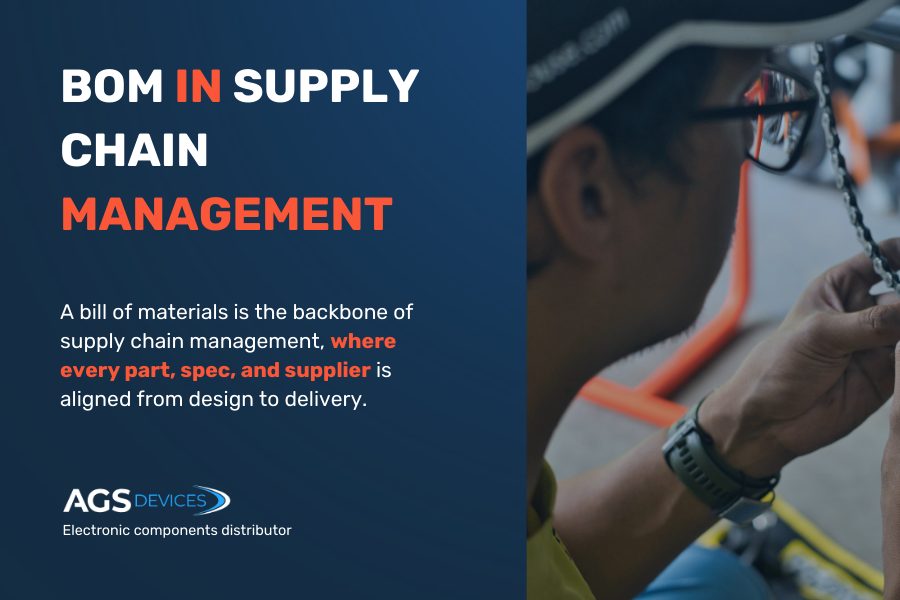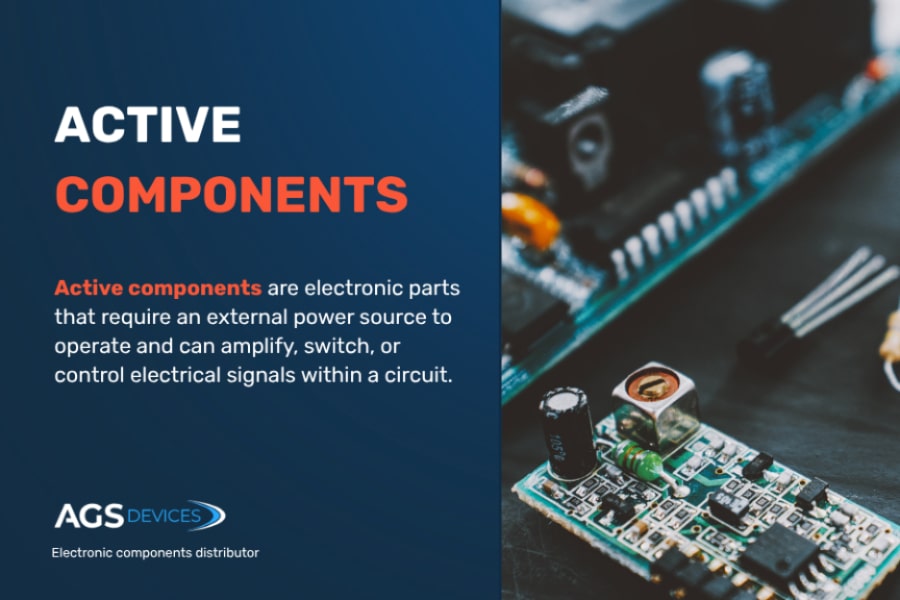
Active Components: Key Takeaways
- Active components regulate, amplify, and switch electrical signals using external power, unlike passive components, which only store or resist energy
- Core types include transistors, diodes, ICs, and power management modules, each serving roles in signal control, logic processing, or voltage regulation
- Whether it’s the logic in your phone or the power supply in a factory robot, active components are what make modern electronics think and act
- Active and passive components work together; the active parts handle logic and control, while passive elements manage timing, filtering, and stability
- AGS Devices ensures reliable sourcing of high-spec active components, offering full traceability, lifecycle support, and quality assurance across high-demand industries
Active components now account for over 60% of global electronic component demand, highlighting just how important they are to modern system design.
Modern systems simply don’t work without them. Active components shape the energy and logic behind every digital decision, from EV acceleration to cloud server uptime.
In this guide, we’ll break down:
- What active components are and how they differ from passive parts
- Core types like transistors, ICs, and diodes
- Real-world applications across medical, automotive, and industrial systems
- Why sourcing quality active parts matters more than ever
What Makes a Component Active
Unlike passive components that only store or resist energy, active components manipulate electrical signals and control energy flow, making real-time responsiveness and amplification possible.
What defines an active component:
- Requires external power: Needs a voltage or current source to operate
- Amplifies signals: Increases voltage, current, or power in a circuit
- Switches or processes signals: Enables on/off logic, modulation, and digital decision-making
- Controls current direction: Can guide or block flow, depending on input conditions
- Responds dynamically: Output changes based on input, making them programmable or adjustable in real time
Functions they enable in electronics:
- Voltage regulation: Maintain constant voltage across variable loads
- Signal conditioning: Clean up, boost, or reshape signals from sensors
- Logic operations: Perform computation in processors and microcontrollers
- Timing and control: Trigger events, manage pulse width, or drive sequences
- Feedback systems: Adjust circuit behavior based on monitored input
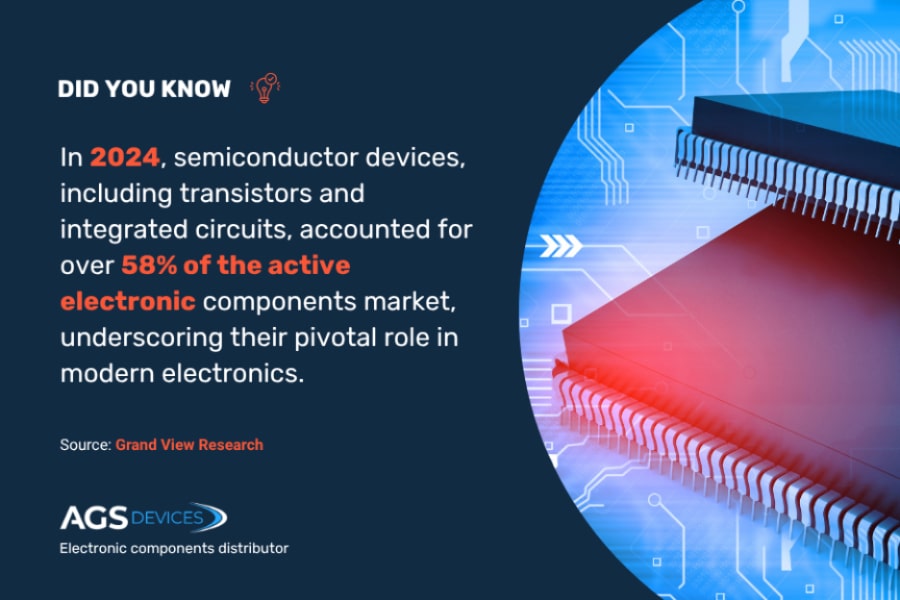
Types of Active Electronic Components
Active components are categorized based on how they interact with current, voltage, and signal control. Each plays a specialized role in modern circuit design, from power regulation to signal processing and amplification.
1. Transistors
Transistors are the fundamental building blocks of switching and amplification in electronics.
- Used for: Signal amplification, digital switching, voltage control
- Types: Bipolar junction transistors (BJTs), field-effect transistors (FETs), MOSFETs
- Found in: Logic gates, motor drivers, audio amps, embedded systems
- Tip: MOSFETs are preferred in power circuits for efficiency and fast switching
2. Diodes
Diodes control current direction and protect sensitive components from voltage spikes or reverse flow.
- Used for: Rectification, voltage regulation, ESD protection, light emission (LEDs)
- Types: Zener diodes, Schottky diodes, Light-Emitting Diodes (LEDs), TVS diodes
- Found in: Power supplies, LED drivers, RF protection, battery circuits
- Note: Zener diodes provide stable voltage references in analog designs
3. Integrated Circuits (ICs)
Integrated circuits combine multiple active (and passive) components into a compact chip that performs complex functions.
- Used for: Logic processing, signal conditioning, power management, communications
- Types: Digital ICs (e.g. microcontrollers), analog ICs (e.g. op-amps), mixed-signal ICs
- Found in: Everything from smartphones to aerospace systems
- Engineering insight: Mixed-signal ICs allow seamless analog-digital conversion in embedded designs
4. Power Modules and Voltage Regulators
These components manage and stabilize the flow of energy through a system.
- Used for: Converting input voltages, protecting circuits, supplying clean power
- Types: LDO regulators, switching regulators (buck/boost), power management ICs
- Found in: Industrial power supplies, automotive ECUs, portable devices
- Sourcing note: Prioritize low-noise regulators for analog-heavy or sensitive circuits
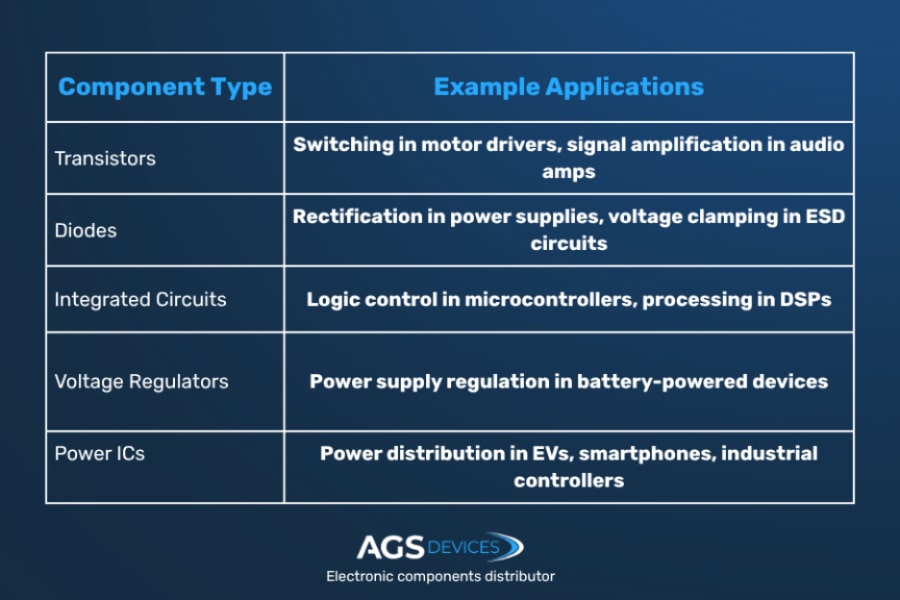
Active Components in Modern Electronics
The ability to amplify, switch, and regulate electrical signals that active components have enables the functionality that modern electronics demand.
Key reasons why active components are essential:
- Enable logic and processing: Integrated circuits (ICs) and transistors form the basis of CPUs, microcontrollers, and signal processors
- Manage real-time power delivery: Voltage regulators and power management ICs adjust energy flow with precision and responsiveness
- Control signal behavior: Diodes and transistors direct current, prevent backflow, and handle switching in real-time
- Drive embedded intelligence: Without active components, embedded systems couldn’t process input, trigger responses, or interface with sensors and actuators
Used in a wide range of systems:
- Consumer electronics: Mobile devices, smart TVs, wearables
- Industrial automation: Motor controllers, PLCs, sensor networks
- Medical equipment: Monitors, diagnostic tools, implantables
- Aerospace and defense: Navigation systems, guidance controls, radar
No modern circuit functions without active elements, they’re the enabling layer that brings power, precision, and programmability to electronics.
Real-World Examples of Active Components
Active components are essential in every industry where electronics are used to sense, control, compute, or communicate.
Below are real-world environments where active elements enable functionality, responsiveness, and precision.
Consumer Electronics
From power management to user interaction, active components drive nearly every circuit inside modern consumer devices.
- Microprocessors manage application logic in smartphones, tablets, and laptops
- Power management ICs regulate battery charging and thermal control
- Audio amplifiers (op-amps, Class-D drivers) boost headphone and speaker signals
- Display drivers and regulators control LCD/OLED panels
- Wireless modules use RF ICs and switching regulators for Bluetooth and Wi-Fi communication
Industrial Control Systems
In factory automation and industrial monitoring, active components ensure system responsiveness, programmability, and load switching.
- Transistor arrays control relay outputs and solenoids in PLCs
- Signal conditioning ICs amplify low-voltage sensor data for analog inputs
- Voltage regulators power control boards and sensor modules
- Logic ICs and microcontrollers manage timing and digital I/O tasks
- Gate drivers and MOSFETs switch motors and actuators efficiently
Medical Devices
Accuracy, noise rejection, and energy efficiency are vital in medical applications, active components help ensure it.
- Op-amps and instrumentation amplifiers boost biosignals from ECG/EEG electrodes
- Low-noise regulators provide stable power to sensitive analog front ends
- Mixed-signal ICs combine ADCs, DACs, and processors for portable diagnostics
- Comparators detect threshold changes in monitoring systems
- Battery protection ICs extend life and reliability in implantable devices
Automotive and Electric Vehicles
From safety to infotainment, active components regulate voltage, process data, and respond to environmental changes.
- MOSFETs and IGBTs regulate power flow in EV motor controllers
- CAN transceivers and logic ICs enable in-vehicle communication
- ADAS modules use processors and analog front ends to interpret radar, lidar, and camera signals
- Battery management ICs monitor cell voltages and temperature
- Linear regulators stabilize sensors and ECUs in harsh environments
Aerospace and Defense
In high-reliability systems, active components must operate under extreme conditions, with no room for failure.
- Radiation-hardened ICs control avionics and satellite communications
- RF amplifiers and mixers support radar and navigation systems
- High-speed comparators enable real-time response in missile guidance
- Precision voltage references stabilize onboard measurement systems
- Transistors and gate drivers manage high-voltage switching in flight systems
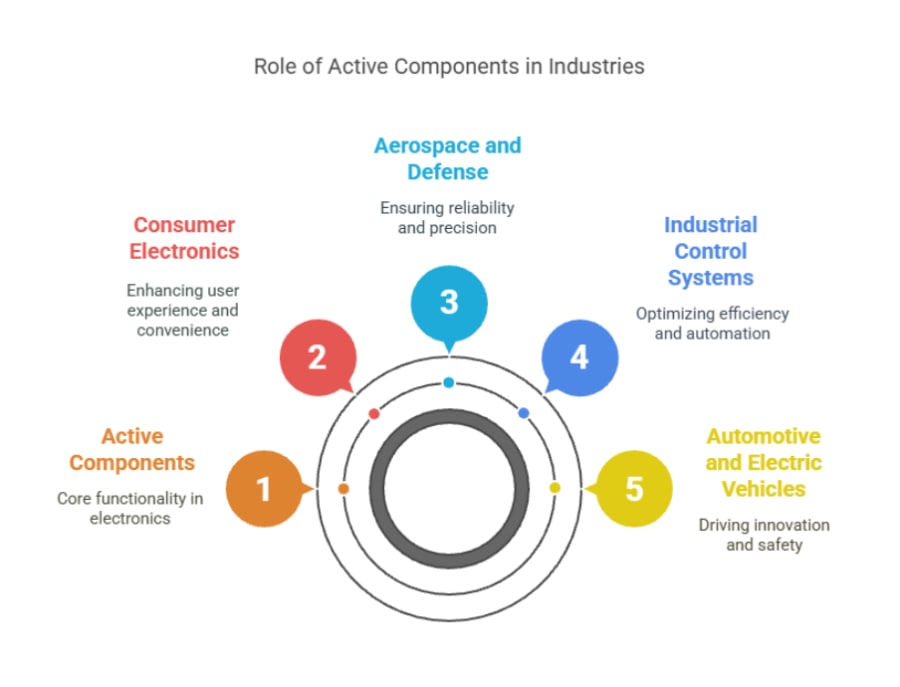
Power Every Circuit With Trusted Active Components From AGS Devices
Talk to any embedded engineer, and they’ll tell you, without transistors and ICs, you’re just connecting wires. These components are the intelligence behind smart systems.
Whether you’re building embedded platforms, scaling industrial automation, or managing obsolescence risk, component reliability starts with sourcing.
At AGS Devices, we deliver:
- Verified active components, including ICs, transistors, and power modules
- Sourcing transparency and lifecycle support across all major sectors
- Engineering-informed procurement for accuracy, spec matching, and performance
- Obsolescence and shortage solutions to keep your production moving
We also provide electronic components such as:
- Power Supply Distributors
- Semiconductors for Sale
- Optoelectronics
- Circuit Protection
- Interconnects
- Passive Components Electronics
- Electronic Testing Equipment
- Electromechanical Devices
When performance and uptime matter, start with sourcing you can trust.
Active Components: FAQs
What are active components in electronics?
Active components are parts that require an external power source to operate. They can amplify signals, control current flow, or perform logical operations, making them central to real-time circuit behavior and processing.
What’s the difference between active and passive components?
Active components modify or generate electrical signals, while passive components only store, dissipate, or resist energy. For example, a transistor (active) can switch current on and off, whereas a resistor (passive) simply limits it.
Can a circuit function with only active components?
No. Most circuits need both active and passive components. Passive parts like resistors, capacitors, and inductors are essential for setting time constants, filtering signals, and managing energy storage.
What are the most common types of active components?
- Transistors (for switching and amplification)
- Diodes (for current direction, protection, and emission)
- Integrated Circuits (ICs) (for logic, control, and processing)
- Voltage regulators and power ICs (for managing power delivery)
How do active components affect sourcing and reliability?
Active components are more sensitive to quality, handling, and counterfeit risks than passive parts. They often have tighter lifecycle constraints, require traceability, and may need performance testing, especially in aerospace, automotive, and medical builds.


